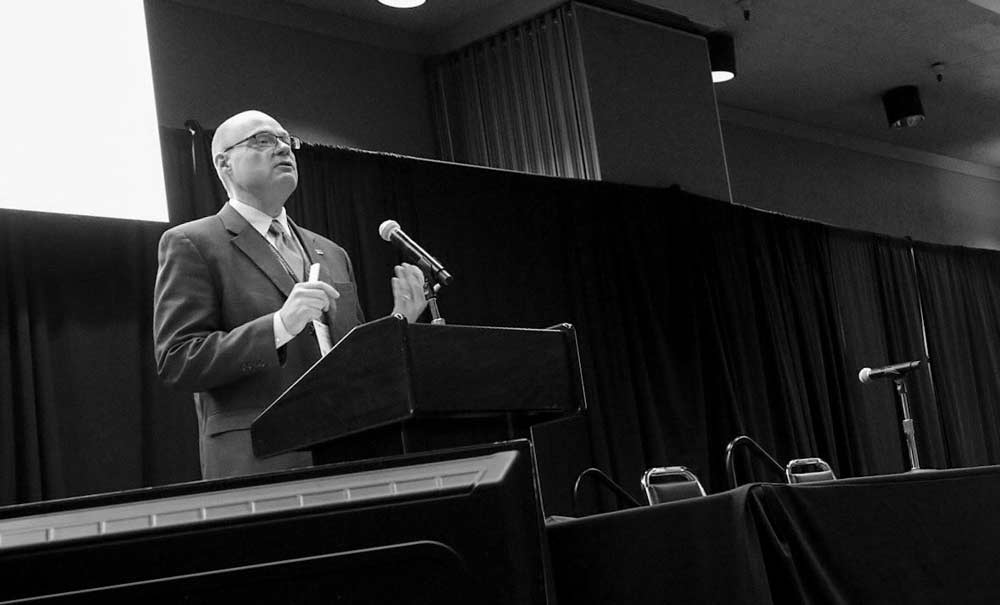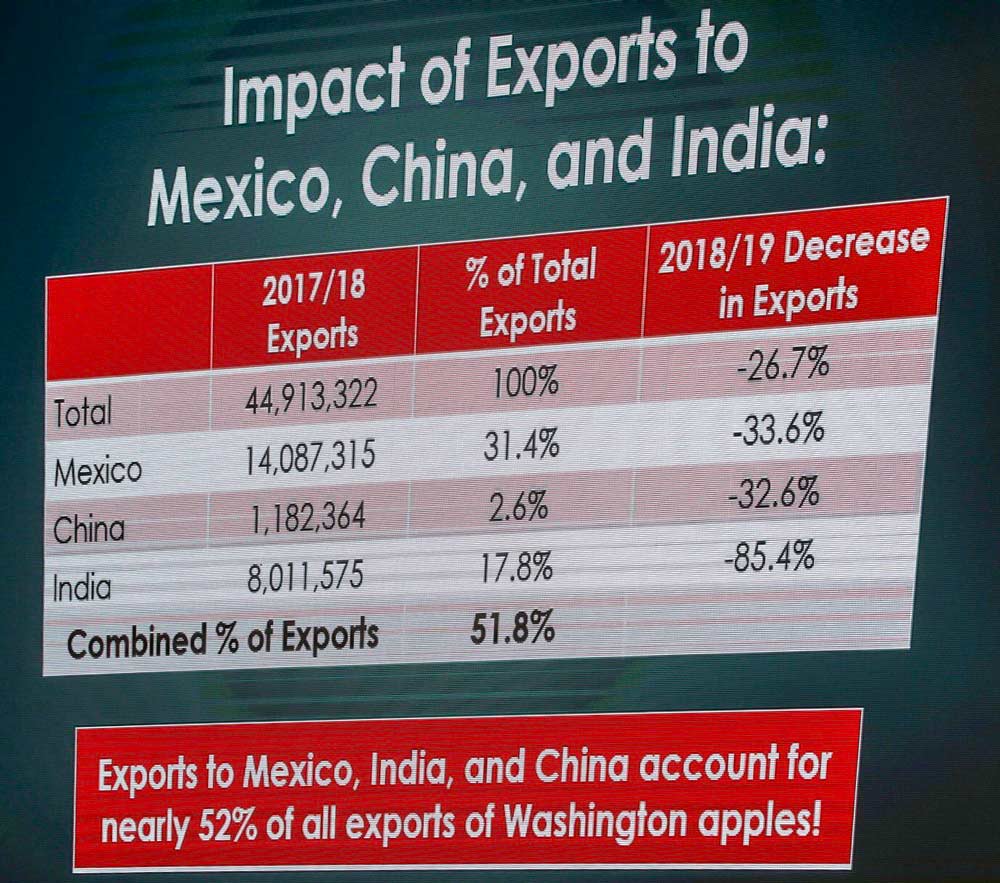
Keynote speaker Vikram Mansharamani covered a wide range of topics on global markets and economic pressures during the 39th Batjer Address at the WSTFA annual meeting. (TJ Mullinax/Good Fruit Grower)
Due to unpredictable politics and demographics, immigration is no longer a reliable way to fill the labor needs of the tree fruit industry, Karen Lewis, Washington State University tree fruit extension specialist, told growers and fruit industry representatives at the 2018 Washington State Tree Fruit Association Annual Meeting on Monday in Yakima, Washington.
Growers must look toward automation and mechanization.
It was just one of the many lessons for growers at the three-day conference, which kicked off Monday with hundreds of participants and a trade show at the nearby Yakima Valley SunDome.
Lewis also reminded growers in Washington they have things pretty good — a good tree fruit climate, a lot of private and public research, a regulatory system largely free of corruption, ample water most years and a culture of career-long learning where even experienced orchardists show up for classes.
Grower Mark Hambelton of MM Orchards discussed using detailed orchard yield and return information to keep a running five-year spreadsheet to “help us make nonemotional decisions about block removal,” while a panel of Mark Matson of Matson Fruit, Scott Crawford of Borton Fruit and Tye Fleming of Helios Nursery discussed several ways to mitigate risks through orchard management.
Washington’s unique environment
Washington’s arid climate isn’t really a natural place to grow trees, but we do, said Washington State University physiologist Lee Kalcsits.
The region gets far more sunshine than the trees can actually make use of. His research shows that netting, which reduces light exposure by 10 to 20 percent, can both protect fruit from sunburn and improve tree productivity, as the trees are not having to deal with offloading the excess light. That’s an opportunity that other regions, with more cloud cover, can’t take advantage of.
Irrigation offers growers in Washington’s desert another advantage. “We are 100 percent reliant on irrigation water,” Kalcsits said. “That’s an opportunity because we can control that supply, we can provide the right amounts at the right time.”
Managing heat is more of a challenge, and in the future the industry needs more cultivars adapted to our climate, he added.
Continuing the theme of environmental stress, a panel addressed a variety of issues on how to watch for stress in your orchards, soil variability, soil moisture management, and their dream technology that would make orchard management effortless.
“I like direct measurements,” said Chris Peters, orchard manager for Valley Fruit Orchards. “Moisture monitors tell you how much is in the soil, but not how much is in the plants.”
The pressure bomb, a tool used to assess the water potential in a leaf sample, has become valuable to gather that direct data, he said, and it’s a tool he wishes he’d had years ago.
It’s also important to monitor soil moisture and plan irrigation on a block-by-block basis, to account for variability in variety and soils, Peters and Greg Paganelli, director of field services for Allan Bros., agreed.
“As for our blocks that have a lot of vigor, we use Apogee, watch the water, and maybe lean them out a little bit,” Paganelli said.
“If we don’t manage to the block, we are probably not doing our job very well,” Peters said. “If you are going to deal with the variability we have in our soils, we have to customize.”
Also Monday…
The keynote speaker, economist Vikram Mansharamani, discussed how to view global changes in demographics, politics and economics as opportunities, not threats.
The conference continues Tuesday with breakout sessions on fire blight management, research reports and Spanish-language presentations. The conference wraps up Wednesday.

Jon DeVaney: We as growers need to be proactive in advocating for what we need and not make ourselves a target of lawmakers. (TJ Mullinax/Good Fruit Grower)

Todd Fryhover: Apple exports to Mexico, China and India are down year to date. Also noteworthy, Mexico, China and India currency values are all less than the dollar, between seven and 12 percent.

How do we get consumers buying apples using social media? Brian Focht: I believe social media drives much of the millennial sales today. Fryhover: The vignettes of growers talking about the great fruit works very well. (TJ Mullinax/Good Fruit Grower)

Mansharamani during Q/A: I’m pretty sure that interest rates are going up in the short term. (TJ Mullinax/Good Fruit Grower)

Quite a crowd watching the competitive system panel in the second half of Monday’s WSTFA annual meeting. (TJ Mullinax/Good Fruit Grower)
-by Ross Courtney and Kate Prengaman






Leave A Comment